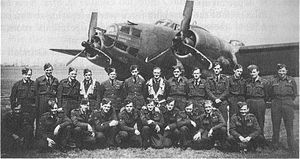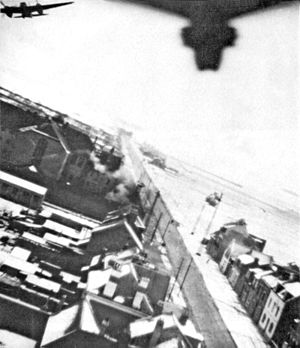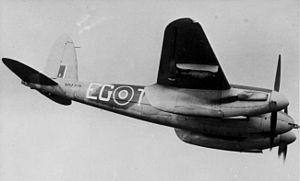- No. 487 Squadron RNZAF
-
No. 487 (NZ) Squadron RAF Active 15 August 1942 - 19 September 1945 Country  United Kingdom
United KingdomAllegiance  New Zealand
New ZealandBranch  Royal Air Force
Royal Air ForceRole Bomber Motto Māori: Ki te mutunga
(Translation: "Through to the end")[1][2]Insignia Squadron Badge A tekoteko holding a bomb[1][2] Squadron Codes EG (Aug 1942 - Sep 1945[1][3][4] Aircraft flown Bomber Lockheed Ventura
de Havilland MosquitoNo. 487 (NZ) Squadron was a Royal New Zealand Air Force bomber squadron, formed under Article XV of the Empire Air Training Scheme. It served in the European theatre during World War II, under the operational command of the Royal Air Force.
Contents
History
No. 487 (NZ) Squadron was formed as a day bomber unit on Venturas, with Royal New Zealand Air Force pilots, at Feltwell, Norfolk on 15 August 1942.[2] The Ventura, an update of the Lockheed Hudson, acquired a poor reputation in Europe, as its performance was not really in the same league as British and German aircraft of the period.
Operations began in December, over the Netherlands. They included a raid on the Phillips factory at Eindhoven[1] and a power station in which the squadron suffered losses. A Ramrod raid (one to be continued regardless of losses), against Amsterdam on 3 May 1943 resulted in the loss of all but one Ventura, (the survivor having turned back with mechanical problems before crossing the coast). Squadron Leader Leonard Trent won the Victoria Cross for his leadership in this raid. He later took part in the "Great Escape".
Following this disaster, No 487 was transferred to the 2nd TAF on 1 June 1943 and in August it began to receive Mosquito FB.Mk.VIs. On 18 February 1944 the squadron took part in the raid on the Amiens prison (Operation Jericho), destroying a wall and enabling over a hundred Resistance prisoners, scheduled for execution, to escape. On 31 October 1944 the squadron destroyed the Gestapo headquarters at Aarhus resulting in the loss of German intelligence records about Resistance activities. In February 1945 the Squadron shifted to liberated Europe. The Gestapo headquarters in Copenhagen received the same treatment on 21 March.
No. 487 Squadron was disbanded on 19 September 1945 (its aircraft and those of its New Zealand aircrew who wished to remain became No. 16 Squadron RAF, retrospectively some weeks later, No. 268 Squadron RAF).[1][2]
The Squadron's Māori motto is "Ki te mutunga", which can also be translated as 'Staying till it ends'. The Squadron code was 'EG'. Apart from the Victoria Cross awarded to Squadron Leader Trent, pilots were awarded 7 DFCs, one Bar to DFC, a DSO and a DFM.
Aircraft operated
Aircraft operated by no. 487 Squadron RNZAF, data from[1][2][5] From To Aircraft Version September 1942 September 1943 Lockheed Ventura Mks.I, II August 1943 September 1945 de Havilland Mosquito FB.Mk.VI Squadron bases
Bases and airfields used by no. 487 Squadron RNZAF, data from[1][2][5] From To Base Remark 15 August 1942 3 April 1943 RAF Feltwell, Norfolk 3 April 1943 20 July 1943 RAF Methwold, Norfolk 20 July 1943 31 December 1943 RAF Sculthorpe, Norfolk 31 December 1943 17 April 1944 RAF Hunsdon, Hertfordshire 17 April 1944 18 June 1944 RAF Gravesend, Kent Detached to RAF Swanton Morley,
Norfolk, 25–30 April 194418 June 1944 2 February 1945 RAF Thorney Island, West Sussex Det. at B.87/Rosières-en-Santerre,
France in December 19442 February 1945 17 April 1945 B.87/Rosières-en-Santerre, France 17 April 1945 19 July 1945 B.58/Melsbroek, Belgium 19 July 1945 19 September 1945 A.75/Cambrai-Épinoy Commanding officers
Officers commanding no. 487 Squadron RNZAF, data from[6][7] From To Name August 1942 December 1942 W/Cdr. F.C. Seavill December 1942 May 1943 W/Cdr. G.J. Grindell May 1943 February 1944 W/Cdr. A.G. Wilson February 1944 August 1944 W/Cdr. I.S. Smith, DFC August 1944 January 1945 W/Cdr. R.C. Porteus January 1945 February 1945 W/Cdr. F.H. Denton, DFC February 1945 August 1945 W/Cdr. W.P. Kemp Surviving Aircraft
One largely complete 487 Squadron aircraft is known to survive, De Havilland Mosquito FB. VI HR339, (later NZ2382) which flew with 487 Squadron in the latter part of 1944 and early 1945. The wings and fuselage aft of the leading edge are with the Ferrymead Aeronautical Society, Christchurch, who are making a composite reconstruction with NZ2328. Some mementos can be seen at the Royal New Zealand Air Force Museum.
A note on New Zealand Squadrons in the RAF
It is now largely accepted that the seven World War II squadrons of the Royal Air Force manned by New Zealanders are recorded by a formulation such as 486 (NZ) Squadron RAF. However some authors (e.g. Bill Gunston) have used a formulation like 486 squadron RNZAF. Some claim the latter is misleading. RNZAF units were a separate entity, formed and controlled entirely by the RNZAF; all RNZAF units operated in the Pacific Theatre. An anomaly exists in that the official badges of the six New Zealand units reads (e.g.:) "486 Squadron Royal New Zealand Air Force".[8] However, as Gerard S Morris explains:
Interestingly, this carried over into the naming of the six New Zealand squadrons...It was impractical, for operational and administrative reasons to establish and maintain RNZAF squadrons in Britain. So, although the squadron badges carried the name Royal New Zealand Air Force, the squadrons were in fact receiving their pay cheques from the British government and official records such as the Operations Record Book acknowledged this. For example, 485 Squadron was referred to informally as 485 (New Zealand) or 485 (NZ) and never as 485 Squadron, RNZAF.(italics added)[9]
On December 19, 1939 Article XV was promulgated, creating the Empire Air Training Scheme. Under this article provision was made for the formation of Commonwealth squadrons within the RAF. On 17 April 1941 a further agreement was negotiated allowing for six New Zealand Squadrons to be formed: 485 Sqn., 486 Sqn., 487 Sqn., 488 Sqn., 489 Sqn. and 490 Sqn. These units were manned and (mostly) commanded by New Zealanders trained under the EATS. provisions, although this didn't preclude other nationalities from being members. Administratively the "Article XV squadrons" were an integral part of the RAF, with all command appointments being made by the RAF. Other Dominion or Commonwealth countries involved were Australia and Canada, along with Rhodesia and South Africa.
Many New Zealanders served with mainstream RAF squadrons and several were to become Wing Commanders and Group Captains. Two outstanding New Zealanders to play a vital role in the war, and two of the best commanders in aviation history were Sir Keith Park and Sir Arthur Coningham.
References
Notes
- ^ a b c d e f g Moyes 1976, p. 261.
- ^ a b c d e f Halley 1988, p. 531.
- ^ Flintham and Thomas 2003, p. 70.
- ^ Bowyer and Rawlings 1979, p. 34.
- ^ a b Jefford 2001, p. 95.
- ^ Bowyer 1984, p. 112.
- ^ New Zealand Electronic Text Centre
- ^ History of squadrons 485 till 490 on rafweb
- ^ Morris 2000, p. 20.
Bibliography
- Bowyer, Chaz. Mosquito Squadrons of the Royal AIr Force. Shepperton, Surrey, UK: Ian Allan Ltd., 1984. ISBN 0-7110-1425-6.
- Bowyer, Michael J.F. and John D.R. Rawlings. Squadron Codes, 1937-56. Bar Hill, Cambridge, UK: Patrick Stephens Ltd., 1979. ISBN 0-85059-364-6.
- Fishman, Jack. And the Walls Came Tumbling Down. MacMillan, 1983.
- Flintham, Vic and Andrew Thomas. Combat Codes: A Full Explanation and Listing of British, Commonwealth and Allied Air Force Unit Codes since 1938. Shrewsbury, Shropshire, UK: Airlife Publishing Ltd., 2003. ISBN 1-84037-281-8.
- Halley, James J. The Squadrons of the Royal Air Force & Commonwealth, 1918-1988. Tonbridge, Kent, UK: Air-Britain (Historians) Ltd., 1988. ISBN 0-85130-164-9.
- Jefford, Wing Commander C.G., MBE, BA, RAF (Retd). RAF Squadrons, a Comprehensive Record of the Movement and Equipment of all RAF Squadrons and their Antecedents since 1912. Shrewsbury: Airlife Publishing, 2001. ISBN 1-84037-141-2.
- Morris, Gerard S. Spitfire, the New Zealand Story. Auckland, New Zealand: Reed Books, 2000. ISBN 0-7900-0696-0.
- Moyes, Philip J.R. Bomber Squadrons of the RAF and their Aircraft. London: Macdonald and Jane's (Publishers) Ltd., 1964 (new edition 1974). ISBN 0-354-01027-1.
- Saunders, James. Venturer Corageous. A Biography of Leonard Trent
- Official New Zealand History (available online)
- Thompson, Wing Commander H.L. New Zealanders with the Royal Air Force (Vol I): European Theatre September 1939-December 1942. Wellington, New Zealand: War History Branch, Department of Internal Affairs, 1953. ISBN N/A
- Thompson, Wing Commander H.L. New Zealanders with the Royal Air Force (Vol II): European Theatre January 1943-December 1945. Wellington, New Zealand: War History Branch, Department of Internal Affairs, 1956. ISBN N/A
External links
Categories:- Royal New Zealand Air Force squadrons
- Military units and formations established in 1942
- Article XV squadrons of World War II
Wikimedia Foundation. 2010.



